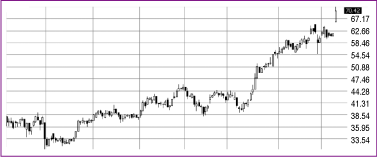Something For Everyone
Why Position Trade?
by Martha Stokes
Position trading offers some good opportunities for current market conditions. Here's how you can benefit.
When the stock market is dominated by short-term traders, the position trade is often forgotten in favor of the better-known daytrading, swing, and option trading techniques. This is unfortunate because position trading offers some excellent opportunities for prevailing current market conditions. The stock market sees long periods of sideways action followed by sudden bursts of price action, both momentum patterns and gap series sequences. This kind of market action, it turns out, is ideal for position trading.
ADVANTAGES FOR OPTION TRADERS
If you learn to position trade, you will develop the skills necessary to determine when a stock is poised to move, how much it is likely to move, and how long the move will take. This is useful if you want to trade options. Time decay is an ever-present risk for buyers of calls and puts. Knowing when, how much, and how long are essential technical skills needed for higher profitability and fewer losses. For writers of calls or puts, being able to accurately determine whether a stock will remain in a tight consolidation or neutral position lowers the risk of being executed and increases your likelihood of success.
Example: Figure 1 shows a typical consolidation pattern for a position trade. Each vertical line indicates a month of price action. The option player who can recognize these entry signals buys during the low-volatility phase and rides out the move as it pops out of the sideways pattern and moves up with velocity. But call writers need to be aware of the time frame when gap patterns are most likely to occur. Recognizing when that stock is going to pop out of its consolidation will help you time your option trade so it coincides with the timing if your option contract expires.

FIGURE 1: TYPICAL CONSOLIDATION PATTERN FOR A POSITION TRADE. In this chart you can see when, where, and how the stock price broke out of the consolidation pattern.
Example: Figure 2 shows an example of a gap series. In today's market, gaps occur frequently after long periods of consolidation. In autumn 2006 there were many stocks that started the gap series patterns. Position traders can take advantage of a gap series, while many other styles of trading miss gap profits. The entry is made during the sideways consolidation pattern prior to the gap.
...Continued in the February issue of Technical Analysis of STOCKS
& COMMODITIES
Excerpted from an article originally published in the February 2007
issue of Technical Analysis of
STOCKS & COMMODITIES magazine. All rights reserved. © Copyright
2007, Technical Analysis, Inc.
Return to February 2007 Contents